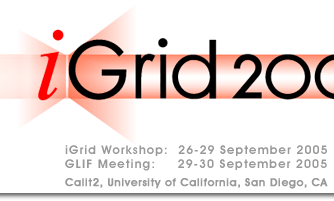Real-Time Applications
First Functional Demonstration of OVC / Terabit LAN with SAGE
URL:
www.evl.uic.edu/cavern/terabitlan/index.html
Contact:
Akira Hirano, Electronic Visualization Laboratory (EVL), University of Illinois at Chicago (UIC), USA and NTT Network Innovation Laboratories, Japan, ahirano @ uic.edu
Collaborators:
EVL, UIC, USA and NTT Network Innovation Laboratories, Japan: Akira Hirano
NTT Network Innovation Laboratories, Japan: Naohide Nagatsu, Yukio Tsukishima, Masahito Tomizawa, Yutaka Miyamoto
EVL, UIC, USA: Rajvikram Singh, Julieta Aguilera, Luc Renambot, Jason Leigh, Andrew Johnson, Tom DeFanti, Byungil Jeong, Lance Long, Alan Verlo, Nicholas Schwarz, Venkatram Vishwanath, Maxine Brown
The Terabit LAN / WAN project focuses on parallelism in switching and transporting multiple lambdas. Switching is done by the applications; applications create a Lambda Group Path (LGP) and specify the number of lambdas, or channels, in each LGP. Each LGP is logically treated as one end-to-end optical path, so during parallel transport, the LGP channels have identical optical paths and no relative latency deviation occurs. However, optical path diversity (due to restoration) or group velocity dispersion in optical fibers can cause LGP relative latency deviations and negatively affect quality of service, particularly in applications involving streaming media. NTT’s OVC (Optical Virtual Concatenation) hardware compensates for relative latency deviations to achieve a virtual terabit bulk transport. Using the EVL-developed SAGE application, 2x1GE video streams are sent from Chicago to San Diego for display on a 2x1 tiled display. An LGP with two channels is established. Tests are performed in which the channels have identical paths and then different paths, and with OVC turned “on” and OVC turned “off.” OVC eliminates relative latency deviation, or jitter, which is visually apparent as poor synchronization between the two images on the tiles of the display. OVC is realized by the OTN (Optical Transport Network) function defined in ITU-T recommendation G.709.


